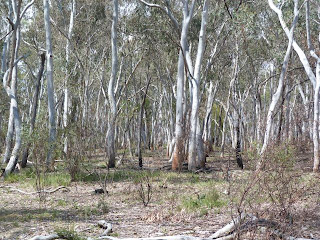Black Mountain orchids and others
I was contacted by Denis to say he was coming to Canberra in the hope of finding a few orchids on Black Mountain and wondered if I would like to join him. Of course the answer was "Yes". So after a bit of excellent advice from Jean about where to go and what was flowering, we met on Belconnen Way and off we set to see what was around. We had a great time: 2 pairs of eyes are a lot better than 1, especially when one of the pairs are attached to Denis!
What follows are my images of the flowers we saw. Denis will post some images on the Nature of Robbo when he returns home.
I'll begin with a general habitat shot. Some of the areas we visited were not quite so badly burnt. At least they didn't fire the place up in peak flowering season and seem, unusually, to have kept it out of the crowns.
In a creek line we found, as suggested, Myrmochila trapeziformis. Interestingly in the Australian Plant Name Index this has reverted to Chiloglottis trapeziformis. To paraphrase the Bard "There are more things in a taxonomist's {Doctor of} Philosophy, Horatio, than are dreamt of in heaven and earth.".
Petalochilus fuscatus earns another photograph by being everywhere, in profusion.
We found several colonies of Stegastyla ustulata.
This Cyanicula caerulea earns a snap with its unusually deep blue colour.
Diusrisnigromontana pardina (those more expert than me are still debating the species ID) was common in the most Northern part of our foray
I think these leaves are of Chiloglottis sp.
Pterostylis nutans was common around the Little Black Mountain trail.
So, once we got our eye in (and kept our lenses out of the labellum), was Bunochilus umbrinus.
I didn't take an image of Glossodia major as I have done them twice this week, and other than being very attractive, there was nothing exceptional about them!
There were of course a lot of other species around I will begin with a prostrate Leptospermum sp.
Comespermum ericinum.
Pomaderris intermedia (ID confirmed from Ian Fraser's blog.)
Phyllanthus hirtellus
We also visited the 6 Mile TSR near (OK, 6 miles from) Bungendore, where I hoped to find a heap of Diuris pardina. In fact we only found two miserable specimens of that species, but a very good display of Craspedia (?)variabilis
What follows are my images of the flowers we saw. Denis will post some images on the Nature of Robbo when he returns home.
I'll begin with a general habitat shot. Some of the areas we visited were not quite so badly burnt. At least they didn't fire the place up in peak flowering season and seem, unusually, to have kept it out of the crowns.
In a creek line we found, as suggested, Myrmochila trapeziformis. Interestingly in the Australian Plant Name Index this has reverted to Chiloglottis trapeziformis. To paraphrase the Bard "There are more things in a taxonomist's {Doctor of} Philosophy, Horatio, than are dreamt of in heaven and earth.".
Petalochilus fuscatus earns another photograph by being everywhere, in profusion.
We found several colonies of Stegastyla ustulata.
This Cyanicula caerulea earns a snap with its unusually deep blue colour.
Diusris
I think these leaves are of Chiloglottis sp.
Pterostylis nutans was common around the Little Black Mountain trail.
So, once we got our eye in (and kept our lenses out of the labellum), was Bunochilus umbrinus.
I didn't take an image of Glossodia major as I have done them twice this week, and other than being very attractive, there was nothing exceptional about them!
There were of course a lot of other species around I will begin with a prostrate Leptospermum sp.
Comespermum ericinum.
Pomaderris intermedia (ID confirmed from Ian Fraser's blog.)
Phyllanthus hirtellus
We also visited the 6 Mile TSR near (OK, 6 miles from) Bungendore, where I hoped to find a heap of Diuris pardina. In fact we only found two miserable specimens of that species, but a very good display of Craspedia (?)variabilis
Two flies possibly creating more flies, and with transparent wing patches. I had never noticed this 'wing effect' before and have now seen it two days in a row.
The first crop of sawfly larvae seen this spring. These were on Black Mountain rather than 6 Mile, but I wanted to put the insect images at the end.


























Comments
I am now in training for my next visit.
Denis
The answer to your question is 'yes'. I think of it as a blueish species.
It is interesting that my companion on the walk was the late Denis Wilson - at that time a resident of Robertson, not a squillion miles from Bundanoon - and he didn't disagree with my ID. Which he would have done promptly had he seen an error!
Martin